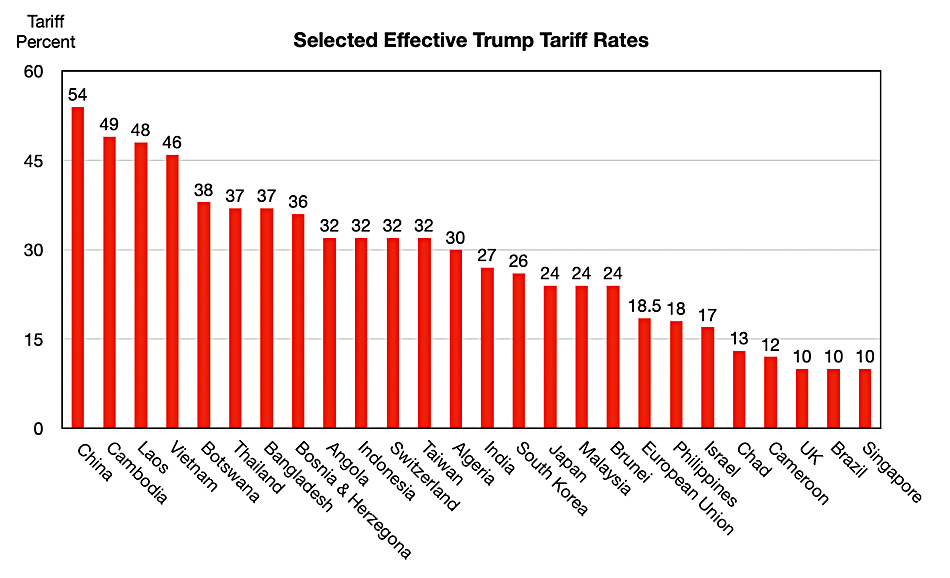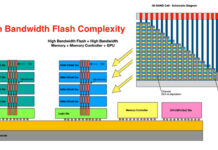Analysis Trump’s tariffs will affect US companies with multinational supply chain components and finished products imported to America, and products from foreign suppliers imported to the US. They will also affect US storage suppliers exporting to tariff-raising countries. There are three groups facing different tariff-related problems.
“This tariff policy would set the US tech sector back a decade in our view if it stays.
Wedbush
Wedbush financial analyst Daniel Ives is telling subscribers to brace themselves: “Investors today are coming to the scary realization this economic Armageddon Trump tariff policy is really going to be implemented this week and it makes the tech investing landscape the most difficult I have seen in 25 years covering tech stocks on the Street. Where is the E in the P/E? No one knows….what does this do to demand destruction, Cap-Ex plans halted, growth slowdown, and damaging companies and consumers globally. Then there is the cost structure and essentially ripping up a global supply chain overnight with no alternative….making semi fabs in West Virginia or Ohio this week? Building hard drive disks in Florida or New Jersey next month?”
And: “…this tariff policy would set the US tech sector back a decade in our view if it stays.”
Here is a survey of some of the likely effects, starting with a review of Trump’s tariffs on countries involved in storage product supply.
China gets the top overall tariff rate of 54 percent, followed by Cambodia on 49 percent, Laos on 48 percent, and Vietnam on 46 percent. Thailand gets a 37 percent tariff imposed, Indonesia and Taiwan 32 percent. India gets 27 percent, South Korea 26 percent, and Japan 24 percent. The EU attracts 18.5 percent and the Philippines 18 percent.

US storage component and product importers
US suppliers with multinational supply chains import components and even complete products to the US. At the basic hardware level, the Trump tariffs could affect companies supplying DRAM, NAND, SSDs, tape, and tape drives, as well as those making storage controllers and server processors.
However, ANNEX II of the of the Harmonized Tariff Schedule of the United States (HTSUS) applies to a presidential proclamation or trade-related modification that amends or supplements the HTSUS. Currently it says that semiconductors are exempt from tariffs.

Semiconductor chips are exempt but not items that contain them as components.
Micron makes DRAM, NAND, and SSDs. The DRAM is manufactured in Boise, Idaho, and in Japan, Singapore, and Taiwan. The exemption could apply to the DRAM and NAND chips but not necessarily to the SSDs that contain NAND, as there is no specific exemption for them. They face the appropriate country of origin tariffs specified by the Trump administration.
Samsung makes DRAM and NAND in South Korea with some NAND made in China. SSD assembly is concentrated in South Korea. The SSDs will likely attract the South Korea 26 percent tariff.
SK hynix makes its DRAM and NAND chips and SSDs in Korea, while subsidiary Solidigm makes its SSD chips in China, implying their US import prices will be affected by the 54 percent tariff on Chinese SSDs and a 26 percent tariff on South Korean ones.
Kioxia NAND and SSDs are made in Japan and the SSDs bought in America will attract a 24 percent tariff – which suppliers will pass on to US consumers, in part or in full. SanDisk NAND is made in Japan (with Kioxia), but we understand some of its SSDs are manufactured in China – which means a 54 percent tariff might apply. That means Kioxia SSDs, Samsung and SK hynix SSDs, but not Solidigm ones, could cost less than Sandisk SSDs.
Consider Seagate and its disk drives. It has component and product manufacturing and sourcing operations in an integrated international supply chain involving China, Thailand, Singapore, and Malaysia.
It makes disk drive platters and some finished drives – Exos, for example – in China, and spindle motors, head gimbal assemblies, and other finished drives in Thailand. Platters and some other drives are assembled in Singapore and Malaysia. Trump’s tariffs will apply to finished drives imported into the US, with rates depending on country of origin.
The tariff rates for China, Malaysia, Singapore, and Thailand are 54 percent, 24 percent, 10 percent, and 36 percent respectively. If Seagate raised its prices to US customers by the tariff amounts, the effect would be dramatic.
Western Digital will be similarly affected as it assembles its disk drives in Malaysia and Thailand, and so face tariffs of 24 and 36 percent respectively imposed on these drives.
Toshiba HDDs are made in China, the Philippines, and Japan, implying US import tariffs of 54, 18, and 24 percent respectively.
IBM makes tape drives for itself and the LTO consortium in Tucson, Arizona, so there are no Trump tariffs applying to them, only to whatever foreign-made components IBM might be importing.
LTO tape media is made by Japan’s Fujifilm and Sony. Fujifilm makes its tape in the US, in Bedford, Massachusetts, but Sony makes its tape in Japan, meaning it will get a 24 percent tariff applied to tape imports into the US. Fujifilm wins while Sony loses.
Recordable Blu-ray and DVD discs are made in China, India, Japan, and Taiwan, and will have US import tariffs imposed on them depending upon the country of origin.
Storage controllers and server processors are mostly made by Intel with some by AMD.
Intel has CPU fabs in Oregon (Hillsboro), Arizona (Chandler), and New Mexico (Rio Rancho). There are processor assembly, test, and packaging facilities in Israel, Malaysia, Vietnam, China, and Costa Rica. The Leixlip plant in County Kildare, Ireland, also produces a range of processors. This is a complex manufacturing supply chain and Intel will avoid a tariff hit on all its CPUs, and other semiconductor products because of the Annexx II exemptions above. The same applies to AMD processors and Arm chips.
Storage arrays are typically made in the US, with Dell, HPE, and NetApp all manufacturing inside the US. However, Hitachi Vantara makes storage arrays in Japan, so they will receive a 24 percent import tariff. Lenovo’s storage is mostly based on OEM’d NetApp arrays so it might share NetApp’s US country of origin status and so avoid tariffs.
Infinidat outsources its array manufacturing to Arrow Electronics, which has a global supply chain, with the US as a global hub. The actual country of origin of Infinidat’s arrays has not been publicly revealed and lawyers may well be working on its legal location.
Hitachi Vantara looks likely to be the most disadvantaged storage array supplier, at the moment.
Non-US storage suppliers
Non-US storage suppliers exporting to the US will feel the tariff pain depending upon their host country. We understand the country of origin of manufactured storage hardware products will be the determining factor.
EU storage suppliers will be affected – unless they maintain a US-based presence.
One tactic suppliers might use is to transfer to a US operation and so avoid tariffs altogether – although critics have said investing in the US at present, with construction costs up and consumer spending down, is far from a safe bet.
US storage exporters
The third group of affected storage suppliers are the US storage businesses exporting goods to countries including China, which is raising its own tariffs in response. There is now a 34 percent tariff on US goods imported into China, starting April 10. This will affect all US storage suppliers exporting there. For example, Intel, which exports x86 CPUs to China.
We understand that China’s tariffs in reaction to Trump’s apply to the country of origin of the US-owned supplier’s manufactured products and not to the US owning entity. So Intel’s US-made semiconductor chips exported to China will have the tariff imposed by Beijing, but not its products made elsewhere in the world. Thus foreign-owned suppliers exporting storage products to China from the US will have the 34 percent tariff applied but this will not apply to their goods exported to China from the rest of the world.
If other countries outside the US were to follow China’s lead and apply their own import tariffs on US-originated goods, US-based exporters would feel the pain, too.
We believe that one of the general storage winners from this tariff fight is Huawei. It doesn’t import to the US anyway, and is thus unaffected by Trump’s tariff moves. As a Chinese supplier, it is also not affected by China’s tariffs on US-made goods, unlike Lenovo if it imports its NetApp OEM’d arrays into China.








